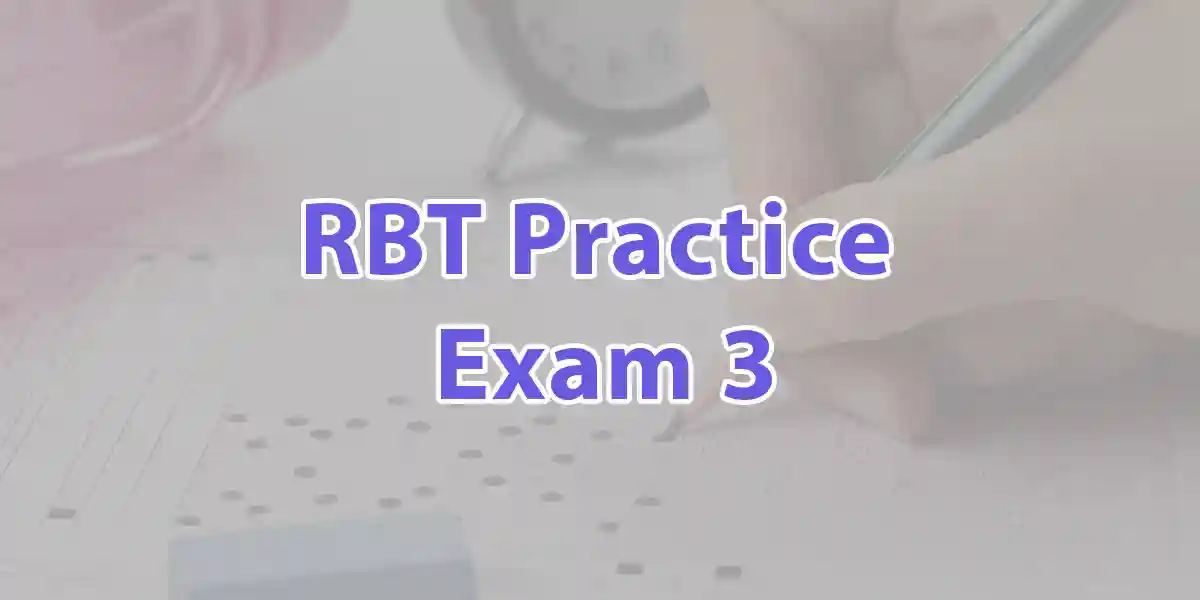Keep Building Confidence with RBT Practice Exam 3
Continue your RBT test prep with 20 more multiple-choice questions. These free sample questions cover a wide variety of important topics that you must know to pass the RBT exam.
The third free RBT practice test contains 20 more challenging questions that help you prepare for the Registered Behavior Technician exam. You’ll see your score and correct answers to each question at the end of this mock test. Analyze your score and find the weak section to put more effort into.
This test is your opportunity to go deeper, challenge your understanding, and refine your test-day performance. It focuses on key areas from the RBT Task List while simulating more nuanced situations that behavior technicians often encounter on the job. Whether you’re nearing the end of your training or just looking to stay sharp, this practice test is a valuable tool for focused review.
Your Next Step Starts Here
Now that you’re here, it’s time to take action. RBT Practice Exam 3 is waiting to show you what you know—and what still needs work. Set aside time, focus, and commit to answering each question thoughtfully.
When you finish, review your results with intention. Take pride in the progress you’ve made so far. Every question is another step closer to the RBT credential and the meaningful work that comes with it.
You’ve got 20 more questions between you and your next level of readiness. Let’s get started.
What to Expect in This Round
By the time you reach this third exam, you’ve already tackled two sets of foundational and intermediate-level questions. This test shifts gears slightly. It introduces more layered scenarios and expects you to recall definitions, procedures, and ethical expectations without being prompted too directly. Think of it as a real-world test of how much you’ve internalized so far.
Each of the 20 questions is designed to mirror how the RBT exam pushes you to apply knowledge, not just remember terminology. Some questions require you to analyze behavioral data, others to identify the correct response in a hypothetical client situation. And every answer is paired with a clear, informative explanation to guide your learning forward.
Why This Practice Test Matters
Every test you take before the real one gives you a significant advantage. Practice Exam 3, in particular, is useful for identifying the last few weak spots before you move into full-length mock exam mode. By this point, you’ve likely formed a solid understanding of behavior reduction, skill acquisition, and ethical guidelines. This test helps confirm the foundation and points out anything you’ve overlooked.
Plus, by seeing your total score and the breakdown of correct versus incorrect answers, you can track improvement across tests. If you’ve been following a structured study plan, you’ll start to notice clearer patterns—whether that means seeing consistent strengths or identifying one or two areas that need more attention.
Topics Covered in RBT Practice Exam 3
The content in this test spans the full range of RBT competencies, with special attention to realistic application. Here are a few topic examples that you’ll find in this test:
- Selecting appropriate interventions for behavior reduction
- Recognizing the correct methods of data collection
- Identifying prompts and fading strategies
- Maintaining client dignity in challenging situations
- Understanding dual relationships and professional boundaries
- Selecting measurement procedures based on behavior type
All these areas are essential to both the exam and the real-world practice of an RBT. That’s why each question on this test is designed not only to assess knowledge but to simulate decision-making that reflects what you might face on the job.
How to Use the Explanations Effectively
What sets this test apart is the way feedback is built into the process. After you complete the test, you’ll not only see your score but also receive detailed rationales for each answer. These are more than simple “right or wrong” notices. Each explanation walks you through the logic behind the correct choice and points out common misconceptions.
These answer breakdowns help you better understand how concepts work in context. They’re also excellent for reinforcing correct reasoning and building long-term retention. When you know why an answer is correct, it’s easier to remember and apply on exam day.
Building Exam Stamina One Step at a Time
One of the hidden benefits of doing these smaller, 20-question tests is that you build endurance gradually. While the official exam has more items and a longer time limit, these bite-sized mock tests allow you to focus deeply without burnout. That’s ideal for learning retention.
Each test trains you to focus, manage time per question, and build the stamina needed to sit for the full certification exam. As you move from test to test, you’ll also get better at identifying question types, eliminating wrong answers quickly, and feeling confident in your choices.
Strategizing Based on Your Score
At the end of RBT Practice Exam 3, you’ll receive a full breakdown of your results. Use that data strategically. Ask yourself:
- Are there content areas I keep struggling with across all practice tests?
- Did I miss questions because I didn’t know the concept or because I misread the question?
- Was I guessing, or did I feel confident?
Your answers to those questions should guide your next study sessions. Focus on the content areas where you’re scoring lowest. If you’re missing multiple questions in “Skill Acquisition,” go back to prompting, task analysis, or generalization principles. If you’re getting tripped up by “Professional Conduct,” spend time with the BACB ethics code and real-life examples.
Avoiding Final-Phase Mistakes
As you near the end of your preparation, it’s important to avoid burnout and overconfidence. Here are a few reminders:
- Don’t rush the review process. Read every explanation, even if you got the question right.
- Avoid memorizing answers. Focus instead on understanding the concepts.
- Time yourself occasionally. Even though this test isn’t timed, practicing under pressure sharpens your speed and focus.
- Review any terms or concepts that feel foggy. Make flashcards or look up visual examples to reinforce them.
The last phase before testing is when most learners either polish their strengths or let bad habits sneak in. Staying focused here will make a huge difference.
Making the Most of the Practice Series
If you’ve already completed Practice Exams 1 and 2, and now you’re on Exam 3, you’re doing the exact kind of layered preparation that sets people up for success. These exams are designed to work as a sequence—each one building on the last.
You’ll notice that your understanding of the test language improves, your anxiety decreases, and your accuracy sharpens over time. That’s no accident. That’s practice turning into confidence.
And once you finish this test, you’ll be ready for our final challenge: Practice Exam 4, which offers a realistic final mock test to simulate the complete experience from start to finish.

